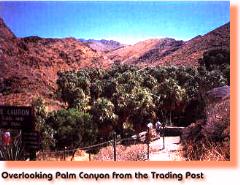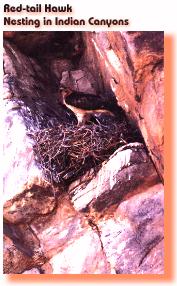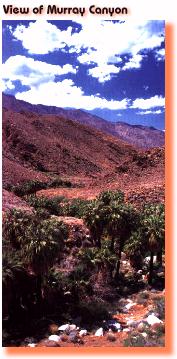The Agua Caliente band of Cahuillas
Centuries ago, ancestors of the Agua Caliente Cahuilla (pronounced Kaw-we-ah) Indians
settled in the Palm Springs area and developed extensive and complex communities in
Palm, Murray, Andreas, Tahquitz and Chino Canyons. Abundant water and hundreds of
plants (Including Palm trees) and animals found throughout the area ensured stable living conditions. Crops of melons,
squash, beans and corn were grown, animals were hunted, and plants and seeds were gathered
for food, medicines, basketweaving etc. Many traces of these communities exist in the canyons
today, including rock art, house pits and foundations, irrigation ditches, dams, reservoirs, trails,
and food processing areas.
The Agua Caliente are members of a large Linguistic and cultural family of Native Americans known to ethnographers as: "Uto-Aztecan Stock".
The family of "Shoshonean" stock includes other nearby Aboriginal neighbors such as: The Moapa Paiutes
of Southern Nevada, the Chemehuevi along the Colorado River, the Tohono O'otam (Papago) along the
Southern Part of Arizona and Northern Mexico and the Pima all the way down to Chihuahua Mexico as
well as many other groups. All of the Groups mentioned along with the Agua Caliente Cahuilla have
been known to use the Washingtonia filifera or Desert Fan Palm; a native palm tree to the areas where
these groups have traditionally lived for many centuries. Uses of these Palms in each of the
mentioned groups is very similar or identical and includes basketry, food in the form of a mush
type gravy and utensils and shelters. Most of the groups have at least some limited oral traditional
mention of the Palm which has been handed down through the many generations. The agua Caliente
bands have perhaps the most detailed oral traditions surrounding this native plant.
The Agua Caliente Indians were industrious and creative
with a reputation for independence, integrity and peace,
They believed this productive land of their ancestors
would  always be theirs, but in 1876 the U.S. Federal
Government deeded in trust, to the Agua Caliente
people, 32,000 acres to be used as their homeland. At the
same time they gave to the So. California Railroad, on
either side of the railroad, ten miles of the odd sections
of land to induce them to build the railroad. Of the
reservation's 32,000 acres, some 6,700 lie within the
Palm Springs city limits. The remaining even sections
fan out across the desert and mountains in a checkerboard pattern. always be theirs, but in 1876 the U.S. Federal
Government deeded in trust, to the Agua Caliente
people, 32,000 acres to be used as their homeland. At the
same time they gave to the So. California Railroad, on
either side of the railroad, ten miles of the odd sections
of land to induce them to build the railroad. Of the
reservation's 32,000 acres, some 6,700 lie within the
Palm Springs city limits. The remaining even sections
fan out across the desert and mountains in a checkerboard pattern.
Though Palm Springs and the surrounding area was described as a
recreational oasis as early as the 1890's, the historical significance
of the three southern canyons, as well as Tahquitz Canyon, is noted
by their listing on the National Register of Historic Places, Palm
and Andreas Canyons have the most and second most palm trees in
the world, with Murray Canyon listed as fourth.
Palm Canyon
Fifteen miles long, Palm Canyon is one of the great beauty spots in
Western North America. Its indigenous flora and fauna, which the
Cahuilla peoples so expertly used, and its abundant Washingtonia
filifera (palm trees), are breathtaking contrasts to the stark, rocky
gorges and barren desert lands beyond. A moderately graded,
paved foot path winds down into the canyon for picnicking near
the stream, meditating, exploring, hiking or horseback riding.
While in Palm Canyon, visit the Trading Post for hiking maps,
refreshments, Indian art and artifacts, books, jewelry, pottery,
baskets, weavings and conversational cultural lore.
Tahquitz Canyon
Tahquitz Canyon, just west of the City of Palm Springs, is noted for its magnificent waterfalls
and pools. Evidence suggests it supported a large population of Cahuilla Indians. Abundant
wildlife and plant life are present throughout. Planning is underway to establish the Agua
Caliente Cultural Museum here in the near future. Note: Entrance to this canyon is not permitted
at this time. Trespassers will be cited.
Murray Canyon
Murray Canyon is an easy hike south from Andreas Canyon. Good
foot and equestrian trails lead to beautiful recreational spots
among the many palm trees. Peninsula Big Horn Sheep (an
endangered species), wild ponies and other wild animals still roam
the high ground above the canyon and can be seen by the lucky
visitor. Being less visited, Murray Canyon has its own secluded
beauty; and at least one known endangered species of bird, the
Least Bells Vireo, is known to nest here.
Andreas Canyon
The contrasting greens of magnificent fan palms and more than
150 species of plants within a half-mile radius beckon the
desert-weary traveler to this lush oasis. A favorite scenic foot trail
leads through the canyon, passing groves of stately skirted palms,
unusual rock formations (some containing Cahuilla Rock Art) and
the perennial Andreas Creek, where one can still see the bedrock
mortars and metates used centuries ago for preparing food. This
tranquil setting is excellent for photography, bird-watching or a
picnic at one of the tables along the trail.
The Agua Caliente people enjoyed a rich and varied ceremonial life, with the sacred and
medically beneficial hot springs often serving as a focal point for these activities. This is similar
to the Moapa bands of Paiutes in Southern Nevada who also held the Warm Springs as sacred
in the old tradition. The site of
the present day Palm Springs Spa Hotel and Mineral Springs is located on a Cahuilla Indian hot
spring. There was first a rough-planked structure in this location, followed years later by a
building containing private bathing cubicles. Today's spa and hotel is noted throughout the
world.
The canyons and associated resources noted above are especially sacred to the Indians today
and are historically important to scientists and lovers of nature. Please enjoy the free gifts of
equanimity and serenity that you may take with you. Appreciate and respect.
Photos: Cover "View of Andreas Canyon"-- Rand Larson; Hawk & Murray Canyon -- George Service; Palm &
Andreas Canyons - F/MC
AGUA CALIENTE BAND
of
CAHUILLA INDIANS
Tribal Council Office
619-325-5673
|
 always be theirs, but in 1876 the U.S. Federal
Government deeded in trust, to the Agua Caliente
people, 32,000 acres to be used as their homeland. At the
same time they gave to the So. California Railroad, on
either side of the railroad, ten miles of the odd sections
of land to induce them to build the railroad. Of the
reservation's 32,000 acres, some 6,700 lie within the
Palm Springs city limits. The remaining even sections
fan out across the desert and mountains in a checkerboard pattern.
always be theirs, but in 1876 the U.S. Federal
Government deeded in trust, to the Agua Caliente
people, 32,000 acres to be used as their homeland. At the
same time they gave to the So. California Railroad, on
either side of the railroad, ten miles of the odd sections
of land to induce them to build the railroad. Of the
reservation's 32,000 acres, some 6,700 lie within the
Palm Springs city limits. The remaining even sections
fan out across the desert and mountains in a checkerboard pattern.

